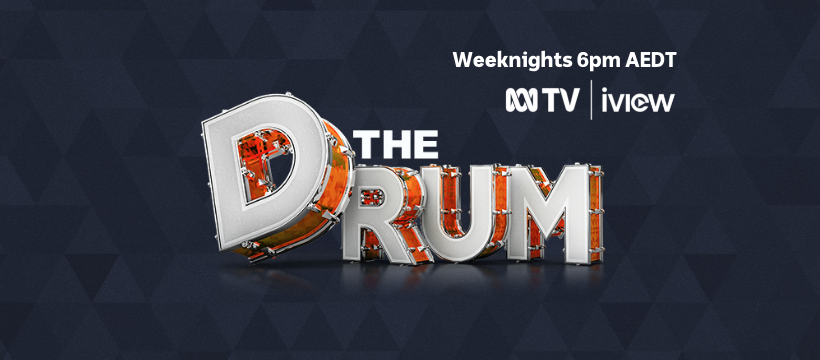RIP The Drum: Now we’re stuck with Q&A.
Two days before ABC-TV’s The Drum went to air with its final program for 2023, we learnt that this was the end of its run. The Drum would not return in 2024. Quite a surprise for the small but loyal audience it had built over 13 years, as well as for many of those monitoring the shifts in strategy and personnel at the ABC over this last year.
At best, this is a puzzling decision. Aside from the loss of the show itself, it opens up a gaping hole in the ABC’s evening schedule leading in to the 7pm news, with no indication yet as to how it will be filled.
While The Drum’s ratings were low, of course, the respected panel show provided a valuable alternative to what now passes for the coverage of politics on free-to-air television news and current affairs.
As a format, it had great integrity. It held true to its commitment to diversity: of participants, of political views, of location, race, ethnicity, gender and sexuality. Its panelists were far from the usual suspects. They included farmers, local councilors, GPs, and community workers along with academics, lawyers, journalists, writers and former politicians. Notably, too, it was successful in ensuring that its diverse sets of panelists interacted with civility and respect. (The only exception I can recall was a just plain nasty contribution from then aspiring Liberal candidate Tim James).
They might have occasionally found themselves with a dud panelist and at times, perhaps, the program may have become a little too earnest for its own good, but in a political climate in which cynicism is the default setting that is an entirely forgivable failing.
The primary anchors in recent years were both accomplished and experienced journalists: Julia Baird (thoughtful, probing and empathic) and Ellen Fanning (excitable, provocative, and persistent). While working from the piles of research on the desk in front of them, they made the complex process of managing the conversation look effortless. It was only when the occasional relief presenter took the chair that the level of skill required became apparent.
But, nonetheless, here we are.
Slim pickings
What’s left for the ABC (indeed, for the nation) in regular political commentary and analysis on prime time broadcast television is now just 7.30 — hopelessly starved of funds and forever looking over its shoulder at the lurking enforcers from the Murdoch press — and the sad spectacle that is now Q&A.
I’ll admit that I always had my reservations, but there were certainly grounds for hope that Q&A could offer an alternative, too. The presence of a live audience asking questions directly of the participants held out the promise of giving us more than the standard party talking points. The strategic incorporation of panelists from outside party politics or the media also suggested that we might yet rescue our politics from the politicians.
But the politicians still showed up. They would dispense with their ties and undo the top button of their business shirts to show that, really, they were just regular folks like the rest of us. (Interestingly, Q&A was one of the earliest places where the suit and no tie tactic was employed in the hope of making politicians more relatable). Malcolm Turnbull’s take on this, famously, was to turn up in his leather jacket.
Even from the beginning, though, the signs were there. Some politicians just couldn’t help themselves. Career-long habits proved hard to break, and so they dutifully reeled off the usual bullshit no matter who was asking the question. Over time, this has become more or less the norm — for politicians from all the major parties. Even (actually, especially) when it defied common sense, they still stayed robotically on message. Some, when pressed, chose to freshen things up a little by patronizing the member of the public who had asked the question.
Over time, the ratings tumbled and a short queue of presenters lined up to jump ship as the whole exercise became drearily predictable.
The slow death of television current affairs
It looks like we are approaching some kind of end point in what has been a three decade, slow motion collapse of mainstream broadcast television’s capacity to cover politics in a way that is well-informed, analytical, principled, insightful — or just useful.
If you are old enough, you might recall that it hasn’t always been like this. There have been periods when we had more choice, more diversity, and a more energetic commitment to generating quality news and current affairs. Over much of the late 80s and early 90s, for instance, our broadcast TV channels all scheduled daily late night news programs as well as some kind of short form prime time current affairs presence, and there was an encouraging interest in trying different ways of presenting current affairs on TV (for instance, The Times, Attitude, The Public Eye, Enough Rope, Clive Robertson’s News World).
Some of that latter spirit still lives on, in its own way, in TEN’s The Project, but, in general and as I was arguing way back in 2005, it has all been downhill since then.
Even if we may not have been regular viewers of The Drum ourselves, as citizens we are entitled to regret the ABC’s termination of a program that took seriously the task of subjecting political issues to civil and informed discussion, and that recognized the need to license a wider range of voices and points of view than are currently represented in our media. The cancellation of The Drum is just one more step, unfortunately, in the shrinking of our public sphere, in the coarsening of our political culture, and in the distressing deterioration of the Australian media’s capacity to provide the range, quality, and level of information required for a functioning democracy.
If you are interested in receiving alerts to new posts on this blog, send me an email at graeme.turner@uq.edu.au



